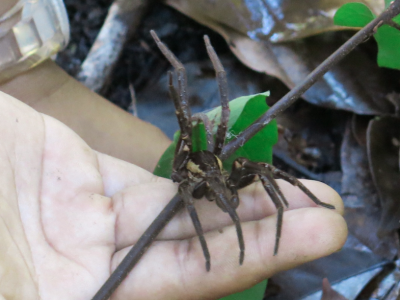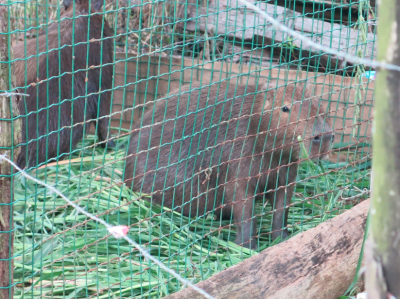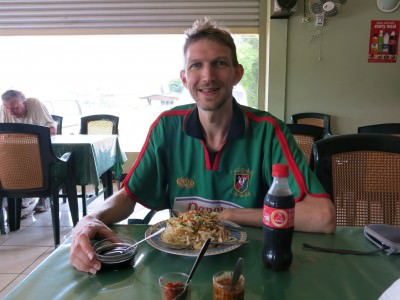“that sugar cane that tasted good. That’s who you are. That’s what you could.” – Michael Stipe, R.E.M. 2001
The former Dutch colony of Suriname is famous for its sugar cane plantations. These days though it’s a thing of the past. The glory days of sugar cane plantations may have gone here in Suriname, but as a keen backpacker you’ll want to read up on your Surinamese history and discover what all the fuss was about. The best way to do this is go there yourself and get booked onto a Sugar Trail Tour, which we did of course!
I will also point out that aside from sugar cane, in general there were a lot of different kind of plantations that flourished in different times in Suriname. So not only sugar. (Also cotton, coffee, cocoa etc) But in a certain period, sugar was the main thing. When the sugar beetroot was discovered in Europe this changed things a lot.
How to book a Sugar Trail Tour in Suriname – Waterproof Suriname
I recommend basing yourself in Paramaribo. It’s the capital city and it’s where all the main companies are based. To book a sugar cane tour use Waterproof Suriname and they also have their website in English. They are experts in organising tours around Suriname and the Sugar Cane Trail comes highly recommended. You can book your tour by email, by phone or call into the office in person. The cost can vary of course, but as of July 2014 is 65 Euros per person. Payment can be in Surinamese Dollars, Euros, US Dollars or PayPal.
The Start of the Sugar Trail Tour
We were asked to meet at 8.30am at the reception of Hotel Krasnopolsky in central Paramaribo – it’s on Domineestraat. We were greeted by our guide for the day. Her name is Njoek and she is local therefore her main language is Dutch. The tour will be conducted in both Dutch and English.
Leaving Paramaribo
We board our mini-bus and it’s just Panny and I with a lot of Dutch tourists. Understandably most of Suriname’s tourists tend to be Dutch! We leave behind Paramaribo and are given a full introduction from Njoek, with expert quirky facts during the journey, including pointing out “hammock” street, the sunken German war ship in the Suriname River and lots of details about Surinamese history. It’s completely informative and fascinating. Suriname is not a common backpacking destination and you’ll really enjoy it.
In our minibus, we cross the bridge over to New Amsterdam and on route to the plantations at Concordia we are also given a soft drink. I choose a white drink called Surinamese Soursop Juice. Nice start to the tour.
Coffee by the Commewijne River
On arrival at this village on the other side of a bridge, it’s morning coffee and biscuits time. We have a choice of tea or coffee and snack on some biscuits. We are given a short introduction about Concordia and where we are heading next. We put our lifejackets on and board the boat.
The Boat to Concordia Plantations
We all board a speedboat to take us along the Commewijne River. It’s a really cool and relaxing journey. We are given a bottle of water each. The sea spray cools us down a notch. Bring some sun cream and insect repellent here.
Njoek our guide gives us more anecdotes and stories along the way as we arrive in a custom made jetty in the middle of the jungle. This is the Concordia Plantations.
Concordia Plantations
This is a fascinating walk through the jungle at the Concordia Plantations. After the sugar cane industry died in Suriname, this place is no longer in use, the glory days were from the late 1880s to the latter part of the 20th Century. My first quick tip is to make sure you bring your insect repellent – we sprayed a lot on but still picked up some bites – spiders, mosquitoes and ants are quite common in this part of the jungle.
First of all we are shown some trees which bear fruit. Then we hear some howler monkeys, but we do not see them. There are lots of unusual plants and trees, at least for me, including “the parrot plant” which when you move it up and down squawks like a parrot! The walk through the jungle leads us to some mills and abandoned engines.
Abandoned Mills and Engines
Here in the middle of a forested jungle sit some remains of old mills and engines that were used in the harvesting and refining process for sugar cane.
Wildlife we Saw/Heard at Concordia
– Lots of birds (heard them)
– Small frogs/toads
– Spiders
– Howler monkeys (heard them)
We board the boat back from Concordia and are given some of the local snack Borrell Chips to share on the journey. We see some odd looking animals including one pictured below called a Capybara. These were in cages at the base before getting the minibus to Tamanredjo. There was also a baby jaguar there.
Lunch at Tamanredjo
After Concordia we drive to Tamanredjo where we stop on the main road for lunch. The restaurant for lunch is a typical Javanese style cuisine – roots from Indonesia of course. We have a choice of lunch and we choose a tofu, chicken and vegetable meal plus a chicken and rice meal. We drink Coca Cola. It’s all included in the tour cost. For extra you can have an alcoholic drink or some chicken satay sticks.
The restaurant was called Warung Toucha.
Driving to Marienburg
We have a short drive through the countryside to arrive at the village of Marienburg. On route again Njoek gives us lots of information about the area, the sugar plantations and the housing style and current vegetation and agriculture. Most houses along the way grwo their own vegetables and fruit.
Touring Marienburg
Marienburg is almost like a custom built village just for the sugar cane plantations. And that’s basically what it was. It’s a bit sad that trade has died away here – the last sugar cane was refined in Suriname in 1998 and Marienburg itself closed in 1986. Now Marienburg serves as a museum and a glimpse of the past. Here are some photos I took, which also includes the only train line that Suriname ever had. For the transport of Sugar Cane of course!
New Amsterdam
We have a quick stop in New Amsterdam and see a war memorial by the river before it’s time for the grand finale – a boat trip back to Paramaribo. We leave our driver here.
The Party Boat Back to Paramaribo!
Yes so at New Amsterdam just before the sun is setting we board a boat back across the Suriname River to Paramaribo. It’s a journey to remember.
Njoek dishes out some local snacks including Borrell Chips and grapefruit. Then she hands out a drinks menu! There are four choices of drinks all including and made with the Surinamese Rum! Despite having been to Suriname in 2011, I never tried the local rum before so this was a first for me.
I opt for the Surprinha, a cocktail made with lime and Surinamese Rum. We all raise a toast as the sun sets we sail back to the capital city. It is truly inspired.
We say our goodbyes on arrival back into Paramaribo and as the sun sinks, I bid a fond farewell to the capital city again. I highly recommend hooking up with Waterproof Tours in Suriname. They also do some awesome river tours and dolphin watching.
Thanks to R.E.M. for the song “Imitation of Life” and that line “that sugar cane, that tasted good.” I hummed it as my boat docked into Paramaribo and on the bus journey out of the Surinamese capital for what may well have been the last time…
Here are some of my videos from what was a great day in Suriname:
You can find more of my sugar cane trail in Suriname on my You Tube Channel:
http://www.youtube.com/user/jonnyscottblair

 : Doing A Sugar Cane Trail From Paramaribo To The Jungle
: Doing A Sugar Cane Trail From Paramaribo To The Jungle































Looks fascinating! Though my first thought was ‘I couldn’t stand those spiders’. Clearly I need to stop letting my terror of spiders prevent me from doing things, but it’s going to be a struggle! I take it that’s your hand holding it in the photo…? Urgh! *shudders*
Katie @ Second-Hand Hedgehog recently posted…What I Learned From #100HappyDays
Hi Katie – thanks for the comment. It was actually the guide that was holding it in the photo. These ones can bite but they’re harmless really. The worst thing was I got loads of ANTS crawling over me! Worth it though – a great trip! Safe travels. Jonny